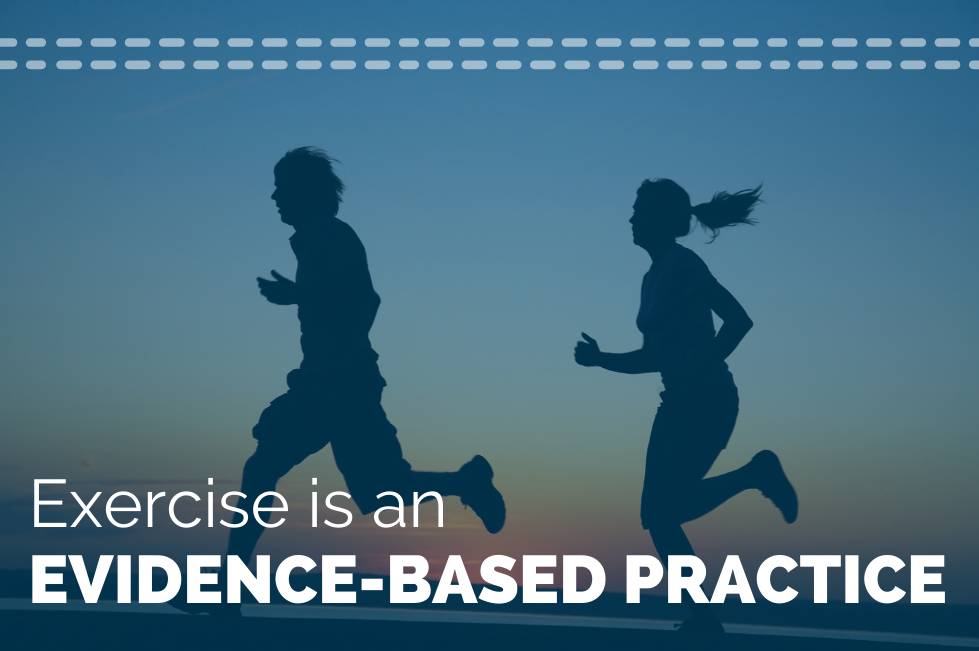Get Moving: Exercise is an Evidence-Based Practice

This article originally appeared in START Connecting in November 2020.
Although it feels like we just started the new school year, winter is coming soon. For many, the chilly temperatures will cause us to hunker down. Playing outside, taking a bike ride, or just going for a walk becomes increasingly difficult when weather dictates we stay inside. If we have learned anything from this year, we know staying still can create restlessness, and for many of our children with Autism Spectrum Disorder (ASD), this can greatly impact mental health, socialization opportunities, and the presence of challenging behavior. How do we combat this?
Physical activity has many benefits, including reducing stress, improving physical health, and creating an opportunity to communicate and socialize with others. In fact, exercise and movement is an intervention backed by research evidence for children, youth, and adults with ASD for improving their social, motor, and cognitive outcomes (Steinbrenner et al., 2020). Research also suggests that getting children and teens with ASD moving can increase attention and reduce challenging behaviors across a variety of settings. This finding is especially important in learning environments (Neely et al., 2015, Nicholson et al., 2010) whether that is at school or during remote learning at home.
Even small exercise breaks throughout the day can make a difference. One study found that giving students two 20-minute breaks during the morning as well as 1 to 5-minute breaks every hour significantly reduced problem behavior in the classroom (Cannella-Malone et al., 2011). These students were given many options for mini workouts, including walking, yoga poses, jumping rope, and simple strength exercises. The teachers discovered that in addition to increasing engagement following the physical activity break, the students truly enjoyed the physical activity! Another study found that giving students with ASD 12-minute jogging/walking breaks around the school gym three times a week was effective in improving academic engagement upon returning to class (Nicholson et al., 2010). Running is not for everyone, but exercise can be fun when kids are allowed to choose from options.
A key to success with this evidence-based practice is to proactively and regularly schedule physical activity breaks, rather than just providing them when we think students need a break from academic instruction. While taking short exercise breaks throughout the day may seem like it takes away from instructional time, teachers will be earning that time back when the students are fully engaged and participating following the brief exercise period.
We see the value of exercise for individuals with ASD, but the next challenge is getting creative with options. There are many resources online that can help you create and plan fun physical activity breaks. You can use visual supports for activities, find age-appropriate YouTube exercise videos, make videos of exercises, or download iPad apps. Keep it simple with a quick walk, yoga poses, stretches, or dance break; this may be all you need to get your student(s) refocused and ready to learn. These exercise breaks don’t have to be long or require extensive equipment to have a meaningful impact. If adults do the exercises along with the students, it can reduce their stress and improve their focus too!
Written by: Amy Matthews, Ph.D., BCBA - Project Director and Samantha Howell, School Psychology Graduate Student
Exercise Resources
- AFIRM Module for Exercise – Evidence-based practice modules (free), including a description, planning, implementing, monitoring, and applying exercise in ASD.
- Autism and exercise: Are there special benefits? – Describes the benefits of exercise and gives strategies for encouraging physical activity.
- Children and Teens with Autism Spectrum Disorder: Considerations and Basic Guidelines for Health and Fitness Professionals – Focused on providing information to the people who are designing exercise programs.
- 5 Important Exercises for Kids with Autism – Describes how exercise can reduce stereotypic, hyperactivity, and aggression behaviors and provides example exercises
References:
Cannella-Malone, H.I., Tullis, C.A., & Kazee, A.R. (2011). Using antecedent exercise to decrease challenging behavior in boys with developmental disabilities and an emotional disorder. Journal of Positive Behavior Interventions, 13(4), 230-239.
Lang, R., Koegel, L. K., Ashbaugh, K., Regester, A., Ence, W., & Smith, W. (2010). Physical exercise and individuals with autism spectrum disorders: A systematic review. Research in Autism Spectrum Disorders, 4(4), 565-576.
Neely, L., Rispoli, M., Gerow, S., & Ninci, J. (2015). Effects of antecedent exercise on academic engagement and stereotype during instruction. Behavior Modification, 39(1), 98-116.
Nicholson, H., Kehle, T.J., Bray, M.A., & Van Heest, J. (2010). The effects of antecedent physical activity on the academic engagement of children with Autism Spectrum Disorder. Psychology in the Schools, 48(2), 198-213.
Shane K H Miramontez, & Schwartz, I. S. (2016). The effects of physical activity on the on-task behavior of young children with autism spectrum disorders. International Electronic Journal of Elementary Education, 9(2), 405-418.
Steinbrenner, J. R., Hume, K., Odom, S. L., Morin, K. L., Nowell, S. W., Tomaszewski, B., Szendrey, S., McIntyre, N. S., Yücesoy-Özkan, S., & Savage, M. N. (2020). Evidence-based practices for children, youth, and young adults with Autism. The University of North Carolina at Chapel Hill, Frank Porter Graham Child Development Institute, National Clearinghouse on Autism Evidence and Practice Review Team.
